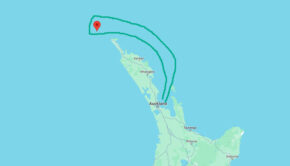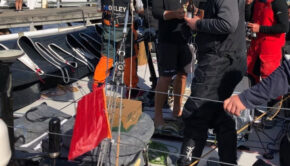Gyber Beware: Know the rule before you round the mark
Published on August 21st, 2013
By Dave Perry, chairman, US Sailing Appeals Committee
I am often asked: “If I am clear ahead at a windward or offset mark beginning a run, do I have the right to gybe onto port if that is my proper course; i.e. can I gybe-set without risk of fouling?” Under the new 2013-2016 rules, the answer is “It depends, but normally No.”
Interestingly, prior to the 2009-2012 rules, the answer had always been No. It was only during the last rule book that the answer was Yes, as long as you were “at” the mark, which pretty much meant alongside the mark. The reason was that under the 2009-2012 rules, mark-room included room to sail your “proper course” while you were “at” the mark. That right was never in the previous rules, and has been removed in the current rules.
Under the current rules, mark-room is simply the space you need to round or pass the mark on the required side in a seamanlike way as necessary to sail the course (see the definition Mark-Room). The “course” means the course needed to begin sailing the next leg, as opposed to your “proper course” (which is your fastest course to the finish).
Mark-room also includes room to sail “to” the mark when your proper course would bring you close to the mark (within a few feet). And if the course to the mark is all port tack, as it would at the gybe mark of a triangle course, then mark-room includes room to sail that course.
Therefore, once you have arrived at the mark and have borne away to your downwind course around the windward or offset mark, you have been given the room you needed to sail to and around the mark and to begin the next leg; i.e., you have been given “mark-room” (see rule 18.2(b), Giving Mark-Room).
If you continue bearing away and roll into a gybe onto port tack, and the boat astern of you has to avoid you, you have broken either rule 11 (the windward-leeward rule) or rule 10 (the port-starboard rule), and you won’t be exonerated (freed from blame) under rule 21, Exoneration, because at the time of the foul you weren’t sailing within the space you were entitled to under mark-room.
If you know you want to gybe-set, you should come in extra high on the approach to the mark and then dive down close to the mark, and try to roll into your gybe just as you are passing the mark to prevent the trailing boat from getting to leeward of you and blocking your gybe.
The rule also provides some assistance. If you come in high enough (at least a boat length) so that you can gybe onto your proper course and sail close to the mark, then you are protected by mark-room (because mark-room is room to sail “to” the mark when your proper course is to sail close to it), as well as by rule 18.2(c)(2) if the boat astern becomes overlapped inside you.
For more on the rules, get Dave Perry’s two books Understanding the Racing Rules of Sailing through 2016 (which includes the complete rule book) and Dave Perry’s 100 Best Racing Rules Quizzes available at US Sailing, 800 US SAIL-1, or http://store.ussailing.org/








 We’ll keep your information safe.
We’ll keep your information safe.